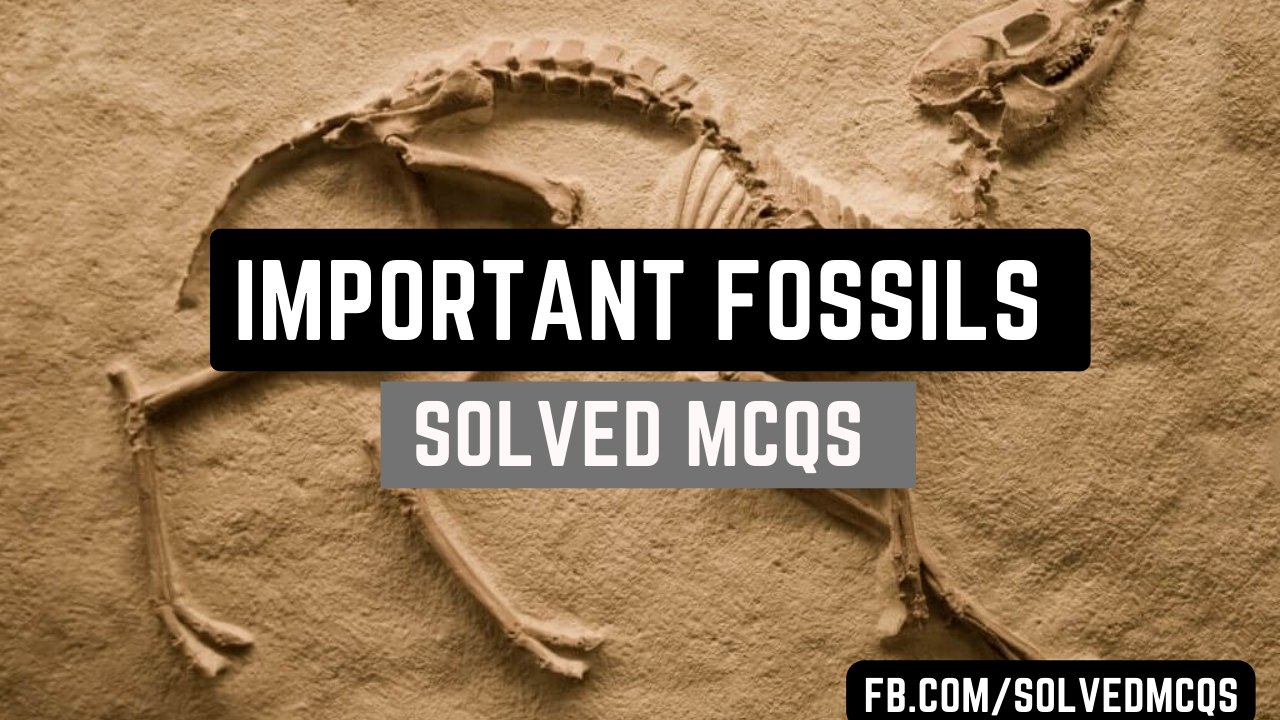Fossil multiple-choice questions MCQs with Answers 1. Fossils are formed in which types of rocks? a. Metamorphic rocks b. Igneou...
1. Fossils are formed in which types of rocks?
a. Metamorphic rocks
b. Igneous rocks
c. Sedimentary rocks
d. None of these
Answer: c. Sedimentary rocks
2. Most evident source of evolution comes from:
a. Analogy
b. Physiology
c. Embryology
d. Paleontology
Answer: d. Paleontology
3. Fossils which are used to tell the relative age of rocks:
a. Prehistoric fossils
b. Primary fossils
c. Secondary fossils
d. Index fossils
Answer: d. Index fossils
4. Which is the characteristic of a good fossil?
a. Must be short-lived
b. Wide geological range
c. Cannot easily decompose
d. All of these
Answer: d. All of these
5. Impression of past found in rocks called fossils, this definition was given by:
a. Charles Lyell
b. Charles Darwin
c. Thomas Malthus
d. A.R Wallace
Answer: a. Charles Lyell
6. Who is the founder of modern paleontology?
a. George Cuvier
b. Leonardo Da Vinci
c. Birbal Sahni
d. Charles Lyell
Answer: a. George Cuvier
7. If the whole body of an extinct organism is found in ice; this is related to:
a. Unaltered fossil
b. Petrified fossil
c. Mould fossil
d. Cast fossil
Answer: a. Unaltered fossil
8. Impression of the external structure of body preserved in the wet soil; this is related to:
a. Mould fossil
b. Cast fossil
c. Print fossil
d. Coprolites
Answer: a. Mould fossil
9. Stony piece of fossils found in animal’s stomach:
a. Gastrolith
b. Coprolites
c. Otoliths
d. Ammonites
Answer: a. Gastrolith
10. The father of “Indian paleontology” is:
a. Birbal Sahni
b. Korana
c. Vijay Gupta
d. J. B Haldane
Answer: a. Birbal Sahni
11. The earliest fossils of foraminifera found in:
a. Permian rock
b. Carboniferous rocks
c. Silurian rock
d. Cambrian rock
Answer: d. Cambrian rock
12. The fossils of Archaeopteryx were found in:
a. Triassic rocks Assam
b. Jurassic rocks of Bavaria
c. Cretaceous rocks of Texae
d. Permian rocks of Russia
Answer: b. Jurassic rocks of Bavaria
13. Which of the following was the first horse in the old world?
a. Merychippus
b. Equips
c. Eohippus
d. Mesohippus
Answer: c. Eohippus
14. Fossil contents of intestine or excreta of many ancient animals:
a. Gastrolith
b. Coprolites
c. Otholiths
d. Ammonites
Answer: b. Coprolites
15. Extinct fossils of Wooly Mammoths were found:
a. 5000 years ago
b. 25000 years ago
c. 10000 years ago
d. 15000 years ago
Answer: b. 25000 years ago
16. Which of the following constitutes a fossil?
a. objects preserved in amber
b. exoskeletons
c. stone imprints of animals
d. All of these
Answer: d. All of these
17. According to Stephen J. Gould, of all of the species of plants and animals that have lived on earth, about what percentage are still alive?
a. 50%
b. 99%
c. 1%
d. 10%
Answer: c. 1%
18. The study of early forms of humans and their primate ancestors is known as:
a. Taphonomy
b. Permafrost
c. Paleoanthropology
d. Paleontology
Answer: c. Paleoanthropology
19. The carbon-14 method was developed by the American physicist Willard F. Libby. Radiocarbon dating can help find the age range of biological specimens from:
a. 500 to 50,000 years old
b. 50 to 5000 years old
c. 5000 to 50,0000 years old
d. 100 to 10,000 years old
Answer: a. 500 to 50,000 years old
20. A subdiscipline of anatomy, anthropology, and paleontology, the detailed study of the structure of bones, skeletal elements, teeth is known as:
a. Osteology
b. Herpetology
c. Entomology
d. Paleoanthropology
Answer: a. Osteology
21. A paleospecies is most often defined from the fossil record based on which of the following?
a. DNA comparisons
b. Morphology
c. reproduction of fertile offspring
d. All of these
Answer: b. Morphology
22. Which of the following fossil is a replica of the original shape of the organism?
a. Preserved remains
b. Mold
c. Trace
d. Cast
Answer: d. Cast
23. Which of the following fossil is an impression left by the original organism?
a. Preserved remains
b. Mold
c. Trace
d. Cast
Answer: c. Trace
24. The Law of Superposition helps allowed geologists to determine the…?
a. The absolute age of rock layers
b. the superpowers of rocks
c. The relative age of rock layers
d. The age of fossils
Answer: c. The relative age of rock layers
25. An insect stuck in amber is an example of what type of fossil?
a. Original remains
b. Mold
c. Trace
d. Cast
Answer: a. Original remains








COMMENTS